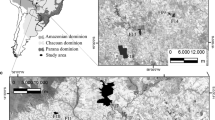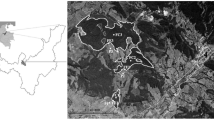Abstract
Anthropogenic disturbances, such as conversion of forests to pastures, are considered one of the major causes of Amazonian biodiversity loss. Pastures are hostile environments for forest species that are not adapted to the adverse conditions of open areas. The aim of this study was to analyze the effects of forest replacement by cattle pastures in the north-eastern part of the Amazonian rainforest using dung beetles (Scarabaeidae: Scarabaeinae) as indicators. Therefore, we determined edge effects and differences in dung beetle species richness, composition, and abundance between forest and neighbouring cattle pastures. A total of 6723 individuals of 63 species of dung beetle were collected. In comparison to forests, adjacent pastures were sharply less rich and abundant in dung beetles. The forests had 6604 individuals and 59 species, while the pastures had 119 individuals and 12 species. The replacement of forests by pastures results in an increase of dung beetle species turnover. Only 12% of dung beetle species were shared by both forest and pasture environments. We highlight that most Amazonian dung beetles are forest species sensitive to abrupt human-driven modification of habitats and are only moderately affected by edge effects.




Similar content being viewed by others
References
Alvares CA, Stape JL, Sentelhas PC et al (2013) Köppen’s climate classification map for Brazil. Meteorol Zeitschrift 22:711–728. doi:10.1127/0941-2948/2013/0507
Anderson MJ (2001) A new method for non-parametric multivariate analysis of variance. Austral Ecol 26:32–46. doi:10.1111/j.1442-9993.2001.01070.pp.x
Audino LD, Silva PG, Nogueira JM et al (2011) Scarabaeinae (Coleoptera, Scarabaeidae) de um bosque de eucalipto introduzido em uma região originalmente campestre. Iheringia Série Zool 101:121–126. doi:10.1590/S0073-47212011000100017
Barona E, Ramankutty N, Hyman G, Coomes OT (2010) The role of pasture and soybean in deforestation of the Brazilian Amazon. Environ Res Lett 5:24002. doi:10.1088/1748-9326/5/2/024002
Braga RF, Korasaki V, Andresen E, Louzada J (2013) Dung beetle community and functions along a habitat-disturbance gradient in the Amazon: a rapid assessment of ecological functions associated to biodiversity. PLoS ONE 8:e57786. doi:10.1371/journal.pone.0057786
da Silva PG, Hernández MIM (2015) Spatial patterns of movement of dung beetle species in a tropical forest suggest a new trap spacing for dung beetle biodiversity studies. PLoS ONE 10:e0126112. doi:10.1371/journal.pone.0126112
Daniel GM, Vaz-de-Mello FZ (2016) Biotic components of dung beetles (Insecta: Coleoptera: Scarabaeidae: Scarabaeinae) from Pantanal–Cerrado Border and its implications for Chaco regionalization. J Nat Hist 50:1159–1173. doi:10.1080/00222933.2015.1103909
de Almeida SSP, Louzada JNC (2009) Estrutura da comunidade de Scarabaeinae (Scarabaeidae: Coleoptera) em fitofisionomias do cerrado e sua importância para a conservação. Neotrop Entomol 38:32–43. doi:10.1590/S1519-566X2009000100003
De Rosario-Martinez H (2015) Phia: post-hoc interaction analysis. R package version 0.2–1. https://CRAN.R-project.org/package=phia
Driscoll DA, Banks SC, Barton PS et al (2013) Conceptual domain of the matrix in fragmented landscapes. Trends Ecol Evol 28:605–613. doi:10.1016/j.tree.2013.06.010
Durães R, Martins WP, Vaz-de-Mellos FZ (2005) Dung beetle (Coleoptera: Scarabaeidae) assemblages across a natural forest-cerrado ecotone in Minas Gerais, Brazil. Neotrop Entomol 34:721–731. doi:10.1590/S1519-566X2005000500003
Escobar F, Halffter G, Arellano L (2007) From forest to pasture: an evaluation of the influence of environment and biogeography on the structure of beetle (Scarabaeinae) assemblages along three altitudinal gradients in the Neotropical region. Ecography 30:193–208. doi:10.1111/j.2007.0906-7590.04818.x
Estrada A, Coates-Estrada R, Dadda AA, Cammarano P (1998) Dung and carrion beetles in tropical rain forest fragments and agricultural habitats at Los Tuxtlas, Mexico. J Trop Ecol 14:S0266467498000418. doi:10.1017/S0266467498000418
Fearnside PM (2007) Brazil’s Cuiabá- Santarém (BR-163) highway: the environmental cost of paving a soybean corridor through the Amazon. Environ Manage 39:601–614. doi:10.1007/s00267-006-0149-2
Feer F (2008) Responses of dung beetle assemblages to characteristics of rain forest edges. Ecotropica 14:49–62
Filgueiras BKC, Tabarelli M, Leal IR et al (2015) Dung beetle persistence in human-modified landscapes: combining indicator species with anthropogenic land use and fragmentation-related effects. Ecol Indic 55:65–73. doi:10.1016/j.ecolind.2015.02.032
Filgueiras BKC, Tabarelli M, Leal IR et al (2016) Spatial replacement of dung beetles in edge-affected habitats: biotic homogenization or divergence in fragmented tropical forest landscapes? Divers Distrib 22:400–409. doi:10.1111/ddi.12410
Fincher GT (1973) Dung beetles as biological control agents for gastrointestinal parasites of livestock. J Parasitol 59:396–399. doi:10.2307/3278842
Gardner TA, Barlow J, Araujo IS et al (2008) The cost-effectiveness of biodiversity surveys in tropical forests. Ecol Lett 11:139–150. doi:10.1111/j.1461-0248.2007.01133.x
Halffter G (1991) Historical and ecological factors determining the geographical distribuition of beetles (Coleoptera: Scarabaeidae: Scarabaeinae). Folia Entomol Mex 82:195–238.
Halffter G, Matthews G (1966) The natural history of dung beetles of the subfamily Scarabaeinae (Coleoptera: Scarabaeinae). Folia Entomol Mex 12:1–312.
Horgan FG (2007) Dung beetles in pasture landscapes of Central America: proliferation of synanthropogenic species and decline of forest specialists. Biodivers Conserv 16:2149–2165. doi:10.1007/s10531-006-9145-3
IBGE (2012) Manual técnico da vegetação brasileira: sistema fitogeográfico, inventário das formações florestais e campestres, técnicas e manejo de coleções botânicas, procedimentos para mapeamentos, 2nd edn. IBGE-Instituto Brasileiro de Geografia e Estatística, Rio de Janeiro
Klein BC (1989) Effects of forest fragmentation on dung and carrion beetle communities in central Amazonia. Ecology 70:1715. doi:10.2307/1938106
Korasaki V, Braga RF, Zanetti R et al (2013) Conservation value of alternative land-use systems for dung beetles in Amazon: valuing traditional farming practices. Biodivers Conserv 22:1485–1499. doi:10.1007/s10531-013-0487-3
Larsen TH, Forsyth A (2005) Trap spacing and transect design for dung beetle biodiversity studies. Biotropica 37:322–325. doi:10.1111/j.1744-7429.2005.00042.x
Laurance WF (2008) Theory meets reality: how habitat fragmentation research has transcended island biogeographic theory. Biol Conserv 141:1731–1744. doi:10.1016/j.biocon.2008.05.011
Laurance WF, Lovejoy TE, Vasconcelos HL et al (2002) Ecosystem decay of Amazonian forest fragments: a 22-year investigation. Conserv Biol 16:605–618
Laurance WF, Trans P, Lond RS (2004) Forest-climate interactions in fragmented tropical landscapes. Philos Trans R Soc B Biol Sci 359:345–352. doi:10.1098/rstb.2003.1430
Laurance WF, Camargo JLC, Luizão RCC et al (2011) The fate of Amazonian forest fragments: a 32-year investigation. Biol Conserv 144:56–67. doi:10.1016/j.biocon.2010.09.021
Laurance WF, Sayer J, Cassman KG (2014) Agricultural expansion and its impacts on tropical nature. Trends Ecol Evol 29:107–116. doi:10.1016/j.tree.2013.12.001
Marsh CJ, Louzada J, Beiroz W, Ewers RM (2013) Optimising bait for pitfall trapping of Amazonian dung beetles (Coleoptera: Scarabaeinae). PLoS ONE 8:e73147. doi:10.1371/journal.pone.0073147
Martins CR (2006) Caracterização e manejo da gramínea Melinis minutiflora P. Beauv. (capim-gordura): uma espécie invasora do cerrado. PhD thesis. Universidade de Brasília, p 145
Matavelli RA, Louzada JNC (2008) Invasão de áreas de savana intra-amazônicas por Digitonthophagus gazella (Fabricius, 1787) (Insecta: Coleoptera: Scarabaeidae). Acta Amaz 38:153–158. doi:10.1590/S0044-59672008000100017
Müller H, Griffiths P, Hostert P (2016) Long-term deforestation dynamics in the Brazilian Amazon—uncovering historic frontier development along the Cuiabá–Santarém highway. Int J Appl Earth Obs Geoinf 44:61–69. doi:10.1016/j.jag.2015.07.005
Murcia C (1995) Edge effects in fragmented forests: implications for conservation. Trends Ecol Evol 10:58–62. doi:10.1016/S0169-5347(00)88977-6
Nichols ES, Gardner TA (2011) Dung beetles as a candidate study taxon in applied biodiversity conservation research. In: Simmons LW, Ridsdill-smith TJ (eds) Ecology and evolution of dung beetles. Wiley, New York, pp 267–291
Nichols E, Larsen T, Spector S et al (2007) Global dung beetle response to tropical forest modification and fragmentation: a quantitative literature review and meta-analysis. Biol Conserv 137:1–19. doi:10.1016/j.biocon.2007.01.023
Oksanen JFG, Blanchet R, Kindt P et al (2015) Vegan: community ecology package. R package version 2.0–8. http://CRAN.Rproject.org/package_vegan
Porensky LM, Young TP (2013) Edge-effect interactions in fragmented and patchy landscapes. Conserv Biol 27:509–519. doi:10.1111/cobi.12042
Quintero I, Halffter G (2009) Temporal changes in a community of dung beetles (Insecta: Coleoptera: Scarabaeinae) resulting from the modification and frgamentation of tropical rain forest. Acta Zool Mex 25:625–649.
R Development Core Team (2015) R: a language and environment for statistical computing. R Foundation for Statistical Computing, Vienna. http://www.Rproject.org
Reid WV, Mooney HA, Cropper A et al (2005) Millennium Ecosystem Assessment Synthesis Report. United Nations
Santos-Filho M, Peres CA, da Silva DJ, Sanaiotti TM (2012) Habitat patch and matrix effects on small-mammal persistence in Amazonian forest fragments. Biodivers Conserv 21:1127–1147. doi:10.1007/s10531-012-0248-8
Scheffler PY (2005) Dung beetle (Coleoptera: Scarabaeidae) diversity and community structure across three disturbance regimes in eastern Amazonia. J Trop Ecol 21:9–19. doi:10.1017/S0266467404001683
Scholtz CH, Davis ALV, Kryger U (2009) Evolutionary biology and conservation of dung beetles. Pensoft Publishers, Bulgaria
Silva RJ, Diniz S, Vaz-de-Mello FZ (2010) Heterogeneidade do habitat, riqueza e estrutura da assembléia de besouros rola-bostas (Scarabaeidae: Scarabaeinae) em áreas de cerrado na Chapada dos Parecis, MT. Neotrop Entomol 39:934–940. doi:10.1590/S1519-566X2010000600014
Silva PG, Audino LD, Nogueira JM et al (2012) Escarabeíneos (Coleoptera: Scarabaeidae: Scarabaeinae) de uma área de campo nativo no bioma Pampa, Rio Grande do Sul. Brasil Biota Neotrop 12:246–253. doi:10.1590/S1676-06032012000300024
Silva RJ, Coletti F, Costa DA, Vaz-de-mello FZ (2014) Rola-bostas (Coleoptera: Scarabaeidae: Scarabaeinae) de florestas e pastagens no sudoeste da Amazônia brasileira: levantamento de espécies e guildas alimentares. Acta Amaz 44:345–352. doi:10.1590/1809-4392201304472
Silva RJ, Ribeiro H V, Souza MF, Vaz-de-Mello FZ (2015) Influência da granulometria do solo na estrutura de guildas funcionais de besouros rola-bostas (Coleoptera: scarabaeidae: scarabaeinae) em florestas semideciduais no estado do Mato Grosso, Brasil. Biosci J 31:601–612. doi:10.14393/BJ-v31n1a2015-23525
Silva RJ, Storck-Tonon D, Vaz-de-Mello FZ (2016) Dung beetle (Coleoptera: Scarabaeinae) persistence in Amazonian forest fragments and adjacent pastures: biogeographic implications for alpha and beta diversity. J Insect Conserv 20:549–564. doi:10.1007/s10841-016-9885-7
Spector S (2006) Scarabaeine dung beetles (Coleoptera: Scarabaeidae: Scarabaeinae): an invertebrate focal taxon for biodiversity research and conservation. Coleopt Bull 60: 71–83. doi:10.1649/0010-065X(2006)60[71:SDBCSS]2.0.CO;2
Spector S, Ayzama S (2003) Rapid turnover and edge effects in dung beetle assemblages (Scarabaeidae) at a Bolivian Neotropical forest-savanna ecotone. Biotropica 35:394–404. doi:10.1111/j.1744-7429.2003.tb00593.x
Vaz-de-mello FZ, Edmonds WD, Ocampo FC, Schoolmeesters P (2011) A multilingual key to the genera and subgenera of the subfamily Scarabaeinae of the New World (Coleoptera: Scarabaeidae). Zootaxa 73:1–73
Acknowledgements
We thank to the Fundação de Amparo a Pesquisa do Estado de Mato Grosso for financial support (FAPEMAT - 756935/2011). FZVM is a CNPq fellow and part of this work were funded by CNPq (Conselho Nacional de Desenvolvimento Científico e Tecnológico – 304925/2010-1, 302997/2013-0, 405697/2013-9, 484035/2013-4, 202327/2013-2, 202327/2013-2) and FAPEMAT/CNPq/PRONEM (568005/2014).
Author information
Authors and Affiliations
Corresponding author
Electronic supplementary material
Below is the link to the electronic supplementary material.
Rights and permissions
About this article
Cite this article
Silva, R.J., Pelissari, T.D., Krinski, D. et al. Abrupt species loss of the Amazonian dung beetle in pastures adjacent to species-rich forests. J Insect Conserv 21, 487–494 (2017). https://doi.org/10.1007/s10841-017-9988-9
Received:
Accepted:
Published:
Issue Date:
DOI: https://doi.org/10.1007/s10841-017-9988-9




